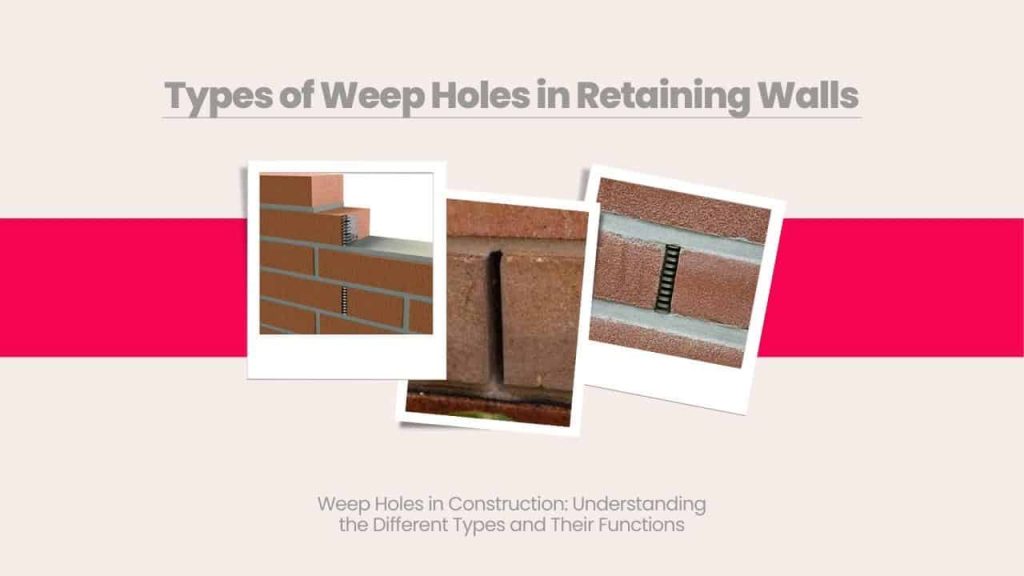
Retaining walls are structures that are designed to hold back soil and prevent erosion. They are commonly used in landscaping and construction projects to create level surfaces on sloped terrain. One important feature of retaining walls is the presence of weep holes, which allow water to drain from behind the wall and prevent damage to the structure. However, not all weep holes are created equal, and there are different types of weep holes that are used in retaining walls. In this blog, we will explore the various types of weep holes in retaining walls and their functions.
What is a Weep Hole?
Weep holes serve as small openings or gaps that facilitate water drainage from a structure’s wall, foundation, or other components. They help to prevent water accumulation that can cause structural decay or damage. Typically, these outlets are placed at the bottom of walls or foundations, where they can drain water away most effectively. Weep holes can be found in different types of construction, including brick, masonry, and concrete structures.
Types of Weep Holes
1) Mortar Joint Weep Holes
Mortar joint weep holes are the most commonly used type of weep holes in construction. They are usually found in brick or masonry walls and serve the purpose of draining water away from the wall’s interior. The gaps in the mortar joint between the bricks or masonry units create the mortar joint weep holes. These gaps can vary in size depending on the wall’s design, with some as small as 3/16 inches and others as large as 3/8 inches. Having mortar joint weep holes is crucial in preventing water damage to a building’s walls, which can be costly to repair and maintain.
2) Vented Cavity Weep Holes
Contractors use vented cavity weep holes frequently while constructing cavity walls. Typically, these walls have a small gap between the inner and outer walls, which is filled with insulation. However, water can seep into the cavity and create a risk of mold and decay when it penetrates the outer wall. To prevent damage to the structure, vented cavity weep holes are designed to allow any water that enters the cavity to escape. These weep holes are strategically placed to ensure that the insulation remains dry and the structure stays sound.
3) Surface-Mounted Weep Holes
Builders opt for surface-mounted weep holes in situations where incorporating a weep hole directly into a structure is not feasible. For example, if a concrete foundation has been coated with waterproofing material, surface-mounted weep holes are a practical choice. These weep holes are installed by mounting a small plastic or metal device onto the surface of the foundation or wall, creating an opening that enables any accumulated water to drain away from the structure.
4) Foundation Weep Holes
Construction engineers use foundation weep holes in concrete foundations to prevent the accumulation of water. They usually position these weep holes at the base of the foundation, and they are usually 2 inches in diameter. Engineers install a grate or screen on the weep hole to prevent debris from entering the structure. These weep holes allow any water that enters the foundation to drain away, protecting the structure from damage or decay.
5) Window Weep Holes
Builders often install window weep holes in window frames to prevent water accumulation that can damage or decay the structure. These weep holes are generally located at the bottom of the window frame to allow any water that enters the frame to drain away from the interior. Window weep holes are found in various types of window frames, including those made of wood, vinyl, or aluminum, and are usually small in size. It is important to properly install and maintain window weep holes to prevent water damage and ensure the longevity of the window frame.
Conclusion
To conclude, weep holes play a crucial role in modern construction by preventing water damage and decay to structures. They are utilized in various types of construction such as brick, masonry, and concrete structures. The choice of weep hole to use depends on the design and location of the structure, and the most frequently used type is mortar joint weep holes. By facilitating the drainage of water away from the structure, weep holes help in maintaining the safety and structural integrity of buildings for an extended period.
Try Onsite, #1 Tool For Site Tracking











